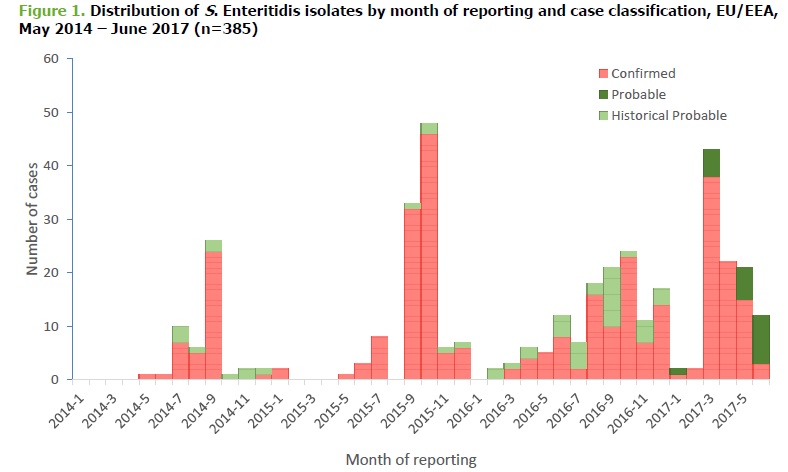There are 314 confirmed cases in Austria, France, Ireland, Luxembourg and the UK.
The confirmed case from Luxembourg who travelled to Spain in 2015 died.
Austria, Belgium, Denmark, the Netherlands, Norway and the UK also have 21 probable and 50 historical probable cases.
Multi-country distribution of infected product(s)
The UK has the most infections with 81% of all outbreak cases and 94% of confirmed cases.
Public Health England said outbreaks could be associated with eating poultry products such as meat or eggs.
Multiple suppliers in the UK have been identified that sent eggs to catering sites visited by cases but this has not led to identification of a producer or supplier.
As Austria, France and the UK have isolates within the same WGS cluster from cases without a travel history it is thought the vehicle of infection is distributed to different EU countries.
The European Centre for Disease Prevention and Control (ECDC) said it will offer whole genome sequencing (WGS) services to countries that do not yet have such capacity to ensure they can analyse human isolates linked to the outbreak.
In 2014, 2015 and 2016, outbreak cases peaked in September and October but in 2017 there was an early peak in March. This out-of-season peak was the second largest in the four-year period.
“The outbreak was detected through WGS and is characterised by its long duration with relatively low numbers of cases reported intermittently and peaks of re-emergence in late summer/early autumn between 2014 and 2016. In 2017 this pattern changed, with a peak observed in March,” said ECDC.

Of the 374 cases with information available on gender, 189 are male.
For the 181 cases where information on travel during the incubation period was available, 57 travelled abroad.
Spain and Portugal likely affected
The most commonly reported countries were Spain (60%) and Portugal (14%). All cases from Ireland and Luxembourg were travel-associated.
In Spain and Portugal WGS and/or Multiple-Locus Variable number tandem repeat Analysis (MLVA) are not routinely performed so it is unknown if there is an outbreak in the countries.
However, phage typing is being done on isolates from outbreaks under investigation, and in January and March 2017, two outbreaks of S. Enteritidis PT56 were identified.
S. Enteritidis isolates were detected in two samples in Spain last year but although eggs were traced to a single large farm, the barns and packaging premises were negative for Salmonella.
From the 87 cases with MLVA information, 18 had MLVA profile 2-11-3-3-2 and 68 had MLVA profile 2-12-3-3-2.
One isolate from a confirmed case from Ireland had MLVA profile 2-9-3-3-2. No isolates with MLVA profile 2-9-3-3-2 have been reported to TESSy.
ECDC said the 5-SNP clusters are genetically closely related and are potentially epidemiologically linked to a common source of infection.
“This could indicate that there are one or more vehicles of infection associated with a single source contaminated with multiple strains of S. Enteritidis. Alternatively, there could be more than one vehicle of infection from different sources distributed through the same supply networks.
“Austria, France and the UK report isolates belonging to the same genetic clusters from cases without history of travel abroad in 2017. This is suggestive of a circulation of vehicles of contamination in all three countries.”
ECDC added new cases should be reported to the Epidemic Intelligence Information System for Food- and Waterborne Diseases and Zoonoses (EPIS-FWD) and information shared through the Early Warning and Response System (EWRS).
